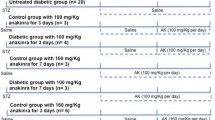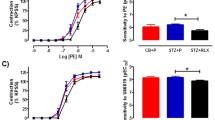Abstract
Background
Serotonin (5-HT) is involved in vascular inflammation and atherosclerogenesis. Serum 5-HT concentrations are elevated in diabetes, and 5-HT is involved in diabetic vasculopathies. Sarpogrelate hydrochloride, a 5-HT2A receptor antagonist, has renoprotective effects, but its effect in diabetic nephropathy is not elucidated. The aim of this study was to examine the effects of sarpogrelate on endothelial dysfunction in rats with streptozotocin (STZ)-induced diabetes.
Methods
Rats with STZ-induced diabetes were either untreated or treated with sarpogrelate (30 mg/kg P.O.) for 8 weeks. At the end of the experiment, we measured urinary albumin excretion, serum adiponectin concentration and platelet-derived microparticles. Intraglomerular coagulation was detected by immunostaining for platelets. Production of renal reactive oxygen species (ROS) and nitric oxide (NO) was investigated by confocal laser microscopy and used as an index of glomerular endothelial dysfunction.
Results
Diabetic nephropathy was associated with enhanced production of ROS and diminished bioavailable NO in the glomeruli. Treatment with sarpogrelate improved ROS/NO imbalance in glomeruli, suppressed platelet aggregation in glomeruli, reduced platelet-derived microparticles, increased serum adiponectin level and reduced the level of albuminuria, compared with non-treated diabetic rats.
Conclusions
Our results indicate that sarpogrelate improves endothelial function in rats with STZ-induced diabetes through a reduction of glomerular platelet activation and an increase in serum adiponectin concentrations and suggest that sarpogrelate is potentially useful for the treatment of diabetic nephropathy.




Similar content being viewed by others
References
Katz MF, Farber HW, Dodds-Stitt Z, Cruikshank WW, Beer DJ. Serotonin-stimulated aortic endothelial cells secrete a novel T lymphocyte chemotactic, growth factor. J Leukoc Biol 1994;55:567–73.
Nagatomo T, Rashid M, Abul Muntasir H, Komiyama T. Functions of 5-HT2A receptor, its antagonists in the cardiovascular system. Pharmacol Ther 2004;104:59–81.
Saxena PR, Villalon CM. Cardiovascular effects of serotonin agonists, antagonists. J Cardiovasc Pharmacol 1990;15(Suppl 7):S17–34.
Eto Y, Nitta K, Uchida K, Tsutsui T, Natori K, Kawashima A, et al. Anti-mitogenic effects of sarpogrelate in cultured rat mesangial cells. Life Sci 1997;60:PL193–9.
Barradas MA, Gill DS, Fonseca VA, Mikhailidis DP, Dandona P. Intraplatelet serotonin in patients with diabetes mellitus, peripheral vascular disease. Eur J Clin Invest 1988;18:399–404.
Kasho M, Sakai M, Sasahara T, Anami Y, Matsumura T, Takemura T, et al. Serotonin enhances the production of type IV collagen by human mesangial cells. Kidney Int 1998;54:1083–92.
Ogawa S, Takeuchi K, Sugimura K, Sato C, Fukuda M, Lee R, et al. The 5-HT2 receptor antagonist sarpogrelate reduces urinary and plasma levels of thromboxane A2 and urinary albumin excretion in non-insulin-dependent diabetes mellitus patients. Clin Exp Pharmacol Physiol 1999;26:461–4.
Takahashi T, Yano M, Minami J, Haraguchi T, Koga N, Higashi K, et al. Sarpogrelate hydrochloride, a serotonin2A receptor antagonist, reduces albuminuria in diabetic patients with early-stage diabetic nephropathy. Diabetes Res Clin Pract 2002;58:123–9.
Parving HH, Hommel E, Mathiesen E, Skott P, Edsberg B, Bahnsen M, et al. Prevalence of microalbuminuria, arterial hypertension, retinopathy and neuropathy in patients with insulin dependent diabetes. Br Med J (Clin Res Ed) 1988;296:156–60.
Satoh M, Fujimoto S, Haruna Y, Arakawa S, Horike H, Komai N, et al. NAD(P)H oxidase and uncoupled nitric oxide synthase are major sources of glomerular superoxide in rats with experimental diabetic nephropathy. Am J Physiol Renal Physiol 2005;288:F1144–52.
Vane JR, Anggard EE, Botting RM. Regulatory functions of the vascular endothelium. N Engl J Med 1990;323:27–36.
Walford G, Loscalzo J. Nitric oxide in vascular biology. J Thromb Haemost 2003;1:2112–8.
Eijkelkamp WB, Zhang Z, Remuzzi G, Parving HH, Cooper ME, Keane WF, et al. Albuminuria is a target for renoprotective therapy independent from blood pressure in patients with type 2 diabetic nephropathy: post hoc analysis from the reduction of endpoints in NIDDM with the angiotensin II antagonist Losartan (RENAAL) trial. J Am Soc Nephrol 2007;18:1540–6.
Gross JL, de Azevedo MJ, Silveiro SP, Canani LH, Caramori ML, Zelmanovitz T. Diabetic nephropathy: diagnosis, prevention, treatment. Diabetes Care 2005;28:164–76.
VanWijk MJ, VanBavel E, Sturk A, Nieuwland R. Microparticles in cardiovascular diseases. Cardiovasc Res 2003;59:277–87.
Nomura S, Suzuki M, Katsura K, Xie GL, Miyazaki Y, Miyake T, et al. Platelet-derived microparticles may influence the development of atherosclerosis in diabetes mellitus. Atherosclerosis 1995;116:235–40.
Omoto S, Nomura S, Shouzu A, Hayakawa T, Shimizu H, Miyake Y, et al. Significance of platelet-derived microparticles and activated platelets in diabetic nephropathy. Nephron 1999;81:271–7.
Yamashita T, Kitamori K, Hashimoto M, Watanabe S, Giddings JC, Yamamoto J. Conjunctive effects of the 5HT(2) receptor antagonist, sarpogrelate, on thrombolysis with modified tissue plasminogen activator in different laser-induced thrombosis models. Haemostasis 2000;30:321–32.
Hara H, Osakabe M, Kitajima A, Tamao Y, Kikumoto R. MCI-9042, a new antiplatelet agent is a selective S2-serotonergic receptor antagonist. Thromb Haemost 1991;65:415–20.
Nomura S, Tandon NN, Nakamura T, Cone J, Fukuhara S, Kambayashi J. High-shear-stress-induced activation of platelets, microparticles enhances expression of cell adhesion molecules in THP-1 and endothelial cells. Atherosclerosis 2001;158:277–87.
Tsunekawa T, Hayashi T, Suzuki Y, Matsui-Hirai H, Kano H, Fukatsu A, et al. Plasma adiponectin plays an important role in improving insulin resistance with glimepiride in elderly type 2 diabetic subjects. Diabetes Care 2003;26:285–9.
Lin J, Hu FB, Curhan G. Serum adiponectin, renal dysfunction in men with type 2 diabetes. Diabetes Care 2007;30:239–44.
Yamakawa J, Takahashi T, Itoh T, Kusaka K, Kawaura K, Wang XQ, et al. A novel serotonin blocker, sarpogrelate, increases circulating adiponectin levels in diabetic patients with arteriosclerosis obliterans. Diabetes Care 2003;26:2477–8.
Kokubu N, Tsuchihashi K, Yuda S, Hase M, Eguchi M, Wakabayashi T, et al. Persistent insulin-sensitizing effects of sarpogrelate hydrochloride, a serotonin 2A receptor antagonist, in patients with peripheral arterial disease. Circ J 2006;70:1451–6.
Guo Z, Xia Z, Yuen VG, McNeill JH. Cardiac expression of adiponectin, its receptors in streptozotocin-induced diabetic rats. Metabolism 2007;56:1363–71.
Ito T, Ikeda U, Shimpo M, Yamamoto K, Shimada K. Serotonin increases interleukin-6 synthesis in human vascular smooth muscle cells. Circulation 2000;102:2522–7.
Acknowledgments
We thank Prof. F.G. Issa for careful reading and editing of the manuscript. We are also grateful to Mrs. Satomi Hanada, Mrs. Yuki Hamada, Mrs. Mayumi Ono and Mrs. Sawako Tsujita for excellent technical assistance. This study was supported by a Grant-in-Aid for Scientific Research from the Ministry of Education, Science, Sports and Culture, Japan. Sarpogrelate hydrochloride was kindly supplied by Mitsubishi Pharma (Osaka, Japan).
Author information
Authors and Affiliations
Corresponding author
About this article
Cite this article
Kobayashi, S., Satoh, M., Namikoshi, T. et al. Blockade of serotonin 2A receptor improves glomerular endothelial function in rats with streptozotocin-induced diabetic nephropathy. Clin Exp Nephrol 12, 119–125 (2008). https://doi.org/10.1007/s10157-007-0011-8
Received:
Accepted:
Published:
Issue Date:
DOI: https://doi.org/10.1007/s10157-007-0011-8




